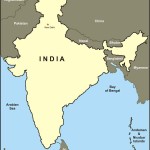The Naxal Problem
The Naxal problem3 is not just a law and order problem. It started with the genuine grievances of the rural poor. The people generally affected are the adivasis and the peasants. But the grievances revolved around land alienation, land distribution, unemployment, exploitation by government officials and contractors, etc., poor remuneration for forest produce, mindless prosecution for petty forest offences, etc. These grievances vary from state to state.
Seventy-six districts and nine states are at present affected by Naxalism. The Naxals have the latest weapons and are not adverse to using warlike extremism in their effort to capture power.
It is but natural that the Naxals see the government, industrialists, traders and landlords as their enemies. They blame the rich classes for the deprivation and hunger suffered by the lower classes, adivasis and poor farmers. Their aim is to overthrow the present system; hence, they target politicians, police officers and men, the CRPF, forest contractors and any one who represents the government in any form.
At the local level, the Naxalites have targeted landlords in the villages, often claiming protection money from them. They have also been known to collect tax from the adivasis and landless villagers under their control.
An indepth look at the problem of Naxalism
The government cannot blame the Naxals totally because they are also the subjects of this nation. But their violence is not acceptable. Naxal groups have been raising mainly land- and livelihood-related issues, and they blame the government and the bureaucracy. India has been facing many challenges in its social, economic and political spheres. Equality, justice and liberty are difficult values to be fulfilled in all spheres. These difficulties are increased and aggravated by the activities of Naxalites because much-needed funds for economic growth have to be diverted towards controlling the Naxal problem. Instead of looking towards the betterment of the people, the government is spending money towards controlling the violence perpetuated by the Naxals. This is nothing if not self-defeating.
| Editor’s Pick |
The Naxals claim that they are fighting for land- and livelihood-related issues. But their attitude is volatile. They believe that administrative and political institutions are inadequate, leading to dissatisfaction. They take advantage of this dissatisfaction. They are trying to run a parallel government which promises to free the oppressed segments of the population from the clutches of the bureaucrats, landlords, etc.
Seventy-six districts and nine states are at present affected by Naxalism. The Naxals have the latest weapons and are not adverse to using warlike extremism in their effort to capture power.
In the last two years, armed attacks in force by the Naxals have grabbed the headlines. The massacre of the CRPF personnel in the Dandakaranya forests and Lalgarh, the attacks in Madhuban in Bihar, and on trains held hostages are all indication that the Naxalites have increased their power of striking. According to the Home Ministry’s estimate, they hold around 6,500 regular weapons, have a hard-core underground cadre of 9,300 and hold a large number of unlicensed country-made arms. Of course a large number of their arms have been looted from the police stations they have raided and the CRPF men they have ambushed and killed. The Naxalites have sophisticated weapons like the Kalashnikov rifles, Claymore landmines, modern wireless equipment and electronic gadgets. Also it has been assessed that the Naxal influence has spread in the past few years from 76 districts across 9 states to 118 districts in 12 states.
The Jharkhand government is setting up a state industrial security force on the lines of the Central Industrial Security Force (CISF) to protect industries as the Naxalites often destroy equipment of business establishments if they are not given extortion money.
The security forces involved in antinaxal operations are convinced, especially in the background of the Madhuban attack, which apparently involved Maoists from Nepal, too, that the CPI (M) is steadily building up a wider network involving associates in neighbouring countries. The Home Ministry is of the view that the wider strategic motive is that of carving out a Compact Revolutionary Zone (CRZ), or what is called a “Red Corridor of armed struggle,” spreading from Nepal through Bihar up to the Dandakarnaya region in Andhra Pradesh.
In the early 1970s, the movement seemed to have reached its peak, with the creation of vast guerrilla zones from West Bengal to Bihar to Uttar Pradesh to Andhra Pradesh. But within a couple of years, the government and the state machinery had them under control.




